
Archaeologists discover extensive burial site on planned Prague Ring Road route
06. 02. 2025
A total of 37 graves from the Migration Period have been uncovered in the cadaster of Prague–Dubeč by researchers from the Institute of Archaeology of the CAS, Prague. These researchers are tasked with investigating the area designated for the planned extension of the Prague Ring Road. Though only the largest and deepest of the discovered graves remained unlooted, this particular grave turned out to be a small archaeological treasure trove.
An iron sword, a knife, a touchstone in a wooden case, a whetstone, and large ceramic vessels – these are just a fraction of the grave goods found preserved in the single undisturbed grave.
“In the burial pit, we identified a peripheral ledge or bench along the longer wall and remnants of a wooden coffin. A spear, likely with its shaft, was placed on the bench during the burial, as its tip was found embedded in the wall of the burial pit. The socket still contained slight traces of the wooden shaft,” describes Petra Maříková Vlčková from the Institute of Archaeology of the CAS, Prague, who is leading the research in this area of the region.
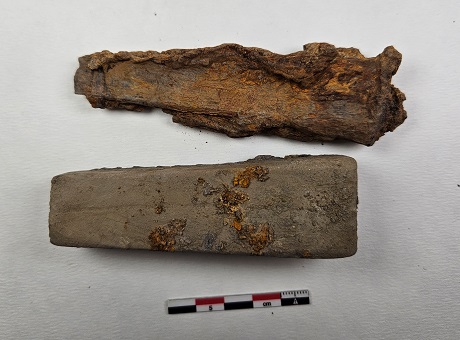
A touchstone from the grave of a presumed warrior from the Migration Period.
Judging by the weapons found, it is likely that a warrior was laid to rest in the grave. However, this is by no means certain. “During the Migration Period, weapons served as symbols of power. Whether the buried individual used them in battle or if they are more indicative of high social status will only be clarified after we analyze the bones, the entire assemblage, and the broader context,” the archaeologist explains.
Rest in peace
The nearly three-meter-deep grave, likely marked on the surface by a small barrow and a shallow ditch, was located away from the main part of the burial ground. This, according to archaeologists, could also suggest that it belonged to someone of exceptional importance.
“From other Migration Period burial sites, we know that the graves of significant individuals were spatially segregated. It seems the community wanted to pay homage by giving them some distance from the other burials,” Vlčková notes.
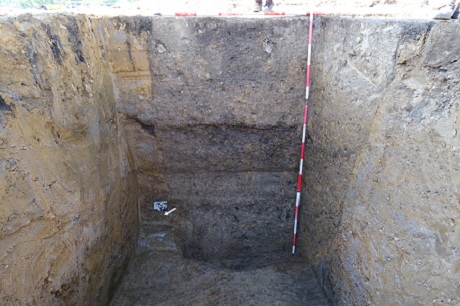
The warrior’s grave was located more than 3 meters below the current ground level.
The other graves discovered at the site had been looted – a characteristic feature of the Migration Period (late fourth to mid-sixth century AD). However, the archaeologists still found several items in them, such as ceramic vessels, iron weapons and ornaments, spindle whorls, and various beads made of glass, semi-precious stones, and amber.
“Some of the beads found originated from Italy, the Near East, or Egypt, proving that Bohemia was fully integrated in long-distance trade networks at the time,” the archaeologist notes. Nevertheless, she emphasized that the discovery of the burial site – and the traces of a settlement nearby, likely from the same period – is significant primarily because it fundamentally complements our understanding of settlement development in one of the most densely populated regions of Bohemia just before the arrival of the Slavs to the Czech “basin”. “While we already have extensive information about the Migration Period from the western and southern parts of the Prague basin, its eastern edge has so far remained largely unexplored,” Vlčková adds.
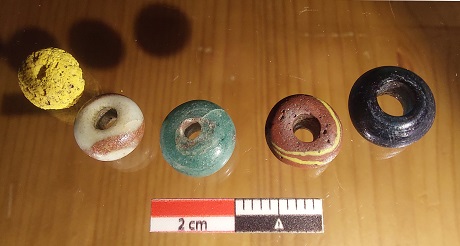
Glass beads were found in one of the graves from the Migration Period.
Holes like Swiss cheese
But the archaeological adventure while examining the area of the planned Prague Ring Road extension does not end there. Traces of human settlement have also been found in other locations. Currently, the archaeologists are uncovering a burial ground from the Bell Beaker culture (Eneolithic/Late Stone Age, 2,500–2,200 BC). So far, they have documented nearly eighty graves in two locations, making this the largest known burial ground of this culture in the Czech Republic.
Interestingly, people living during this period buried their dead in very specific ways. Men were laid on their left sides, with their heads to the north and faces to the east, while women were placed on their right sides with their heads to the south. The deceased were surrounded by grave goods – primarily ceramic vessels, stone tools, and small bone ornaments.
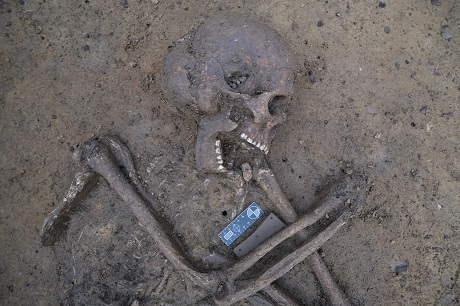
The grave of a warrior with a so-called bracer, which protected archers’ forearms from bowstring injuries (the Eneolithic – Bell Beaker culture).
“Adjacent to one of the burial grounds, we also uncovered a group of forty-five storage pits, which likely date to the same period. The pits were so close together that the excavation area kind of resembled Swiss cheese,” Vlčková describes with a touch of humor.
Before construction begins
The rescue archaeological research project along the planned section of the Prague Ring Road from the D1 motorway to Prague–Běchovice, conducted in cooperation with the Road and Motorway Directorate (ŘSD), began in May 2024. The proposed section runs through an area inhabited and traversed by people since prehistoric times. The research is managed by staff from the Institute of Archaeology of the CAS, Prague, in collaboration with the Institute of Archaeological Heritage of Central Bohemia (Ústav archeologické památkové péče středních Čech) and the company Osina Archeo.
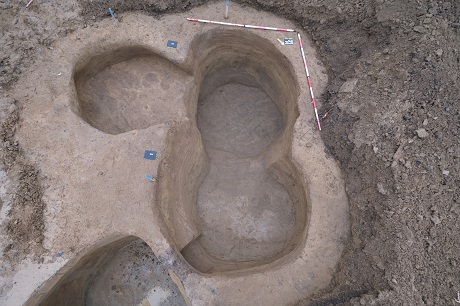
Interconnected storage pits likely dating to the Late Eneolithic period.
Since heavy machinery first entered the missing section of the ring road, researchers have already documented over ten thousand archaeological features. In December 2024, in accordance with the pre-established schedule, they handed over part of the explored area to the Road and Motorway Directorate. The fieldwork is expected to be completed by the end of February 2025, allowing construction to begin. However, the evaluation of field documentation, conservation, and processing of the finds will take researchers several more months to complete.
Written and prepared by: Radka Římanová, External Relations Division, CAO of the CAS, drawing on the CAS press release
Translated by: Tereza Novická, External Relations Division, CAO of the CAS
Photo: Archive of the Institute of Archaeology of the CAS, Prague
 The text is released for use under a Creative Commons license.
The text is released for use under a Creative Commons license.
Read also
- How does the Academy Council plan to strengthen the Academy’s role? Part 2
- How does the Academy Council plan to strengthen the Academy’s role? Part 1
- Ombudsperson Dana Plavcová: We all play a role in creating a safe workplace
- ERC Consolidator Grant heads to the CAS for “wildlife on the move” project
- A little-known chapter of history: Czechoslovaks who fought in the Wehrmacht
- Twenty years of EURAXESS: Supporting researchers in motion
- Researching scent: Cleopatra’s legacy, Egyptian rituals, and ancient heritage
- The secret of termites: Long-lived social insects that live in advanced colonies
- Two ERC Synergy Grants awarded to the Czech Academy of Sciences
- Nine CAS researchers received the 2025 Praemium Academiae and Lumina Quaeruntur
The Czech Academy of Sciences (the CAS)
The mission of the CAS
The primary mission of the CAS is to conduct research in a broad spectrum of natural, technical and social sciences as well as humanities. This research aims to advance progress of scientific knowledge at the international level, considering, however, the specific needs of the Czech society and the national culture.
President of the CAS
Prof. Eva Zažímalová has started her second term of office in May 2021. She is a respected scientist, and a Professor of Plant Anatomy and Physiology.
She is also a part of GCSA of the EU.